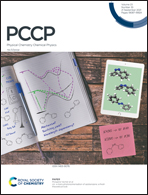A computational investigation of the adsorption of small copper clusters on the CeO2(110) surface†
Abstract
We report a detailed density functional theory (DFT) study of the geometrical and electronic properties, and the growth mechanism of a Cun (n = 1–4) cluster on a stoichiometric, and especially on a defective CeO2(110) surface with one surface oxygen vacancy, without using pre-assumed gas-phase Cun cluster shapes. This gives new and valuable theoretical insight into experimental work regarding debatable active sites of promising CuOx/CeO2-nanorod catalysts in many reactions. We demonstrate that CeO2(110) is highly reducible upon Cun adsorption, with electron transfer from Cun clusters, and that a Cun cluster grows along the long bridge sites until Cu3, so that each Cu atom can interact strongly with surface oxygen ions at these sites, forming stable structures on both stoichiometric and defective CeO2(110) surface. Cu–Cu interactions are, however, limited, since Cu atoms are distant from each other, inhibiting the formation of Cu–Cu bonds. This monolayer then begins to grow into a bilayer as seen in the Cu3 to Cu4 transition, with long-bridge site Cu as anchoring sites. Our calculations on Cu4 adsorption reveal a Cu bilayer rich in Cu+ species at the Cu–O interface.

- This article is part of the themed collection: 2021 PCCP HOT Articles


 Please wait while we load your content...
Please wait while we load your content...